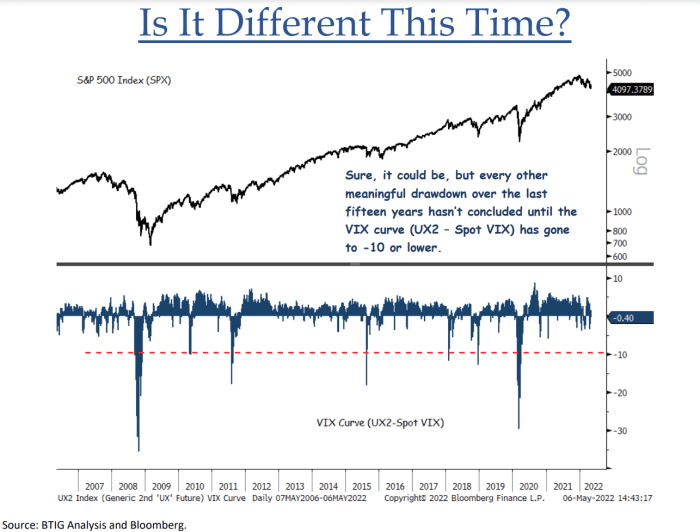Stock-market investors have been on a roller-coaster ride, but a closely watched measure of expected volatility has yet to convincingly signal that the selloff is set to bottom out, analysts said Monday.
The Cboe Volatility Index
VIX,
an options-based measure of expected S&P 500
SPX,
volatility over the next 30 days, rose 13.3% Monday to 34.20, above its long-run mean of 20 but below the level that typically accompanies a market bottom, said Nicholas Colas, co-founder of DataTrek Research, in a note.
The VIX is sometimes referred to as Wall Street’s “fear gauge” because it tends to rise when stocks tumble.
The VIX’s close on Friday at 30.2 left it in a “no-man’s land” between 28 and 36, marking 1- and 2-standard deviations from the long-run mean, he wrote. The VIX did get to 35 in early action as stocks swooned early Friday, likely pulling in algorithmic traders and allowing the market to come back modestly over the course of the day, he said.
“The bottom line here is that the 36 VIX level continues to ‘work’ as a sign of an intraday low, but we’d like to see it close at 36 or higher as evidence of a larger washout in U.S. equities,” Colas wrote. “That really should have happened on Friday, with the yield on the 10-year Treasury ramping to 3.14% and WTI crude back to $110/barrel. But it did not, and so we continue to wait for an investable bottom.”
In One Chart: Stock market selloff in ‘liquidation’ stage. Why it needs to get ‘hotter’ before it burns out.
Stocks saw violent swings last week, soaring on Wednesday after the Federal Reserve delivered a widely expected rate increase of 50 basis points, only to give it all back and then some on Thursday as the Dow dropped more than 1,000 points. Major indexes posted weekly declines on Friday, with the S&P 500 finishing at its lowest since May 19, 2021, while the Dow Jones Industrial Average
DJIA,
posted its lowest close since March and the Nasdaq Composite
COMP,
saw its lowest finish since Nov. 25, 2020.
Stocks extended the fall Monday, with the Dow slumping around 650 points at its session low, while the S&P 500 was down 2.6% to trade at its lowest intraday level since April 2021. The Nasdaq dropped 3.4%, leaving it down more than 25% year to date and trading at its lowest intraday level since November 2020.
The VIX, meanwhile, has yet to take out its April high above 36, much less the March high above 37. Analysts have argued that indicates investors fear an even deeper selloff in coming months as the Fed prepares to continue tightening aggressively in an effort to rein in inflation.
VIX futures also offer little comfort for those looking for a sign the lows are near, said Jonathan Krinsky, technical analyst at BTIG, in a Sunday note. While the nearby May futures contract
VXK22,
is trading at a premium of around 0.55 point to the June contract
VXM22,
the gap needs to widen to send a convincing bottoming signal, he wrote (see chart below).

BTIG
Krinsky said that while this time could be different, every meaningful S&P 500 drawdown of the past 15 years “hasn’t concluded until the VIX curve has gone to -10 or lower.”
Source: https://www.marketwatch.com/story/still-no-stock-market-bottom-signal-from-vix-volatility-gauge-market-watchers-say-11652101685?siteid=yhoof2&yptr=yahoo
